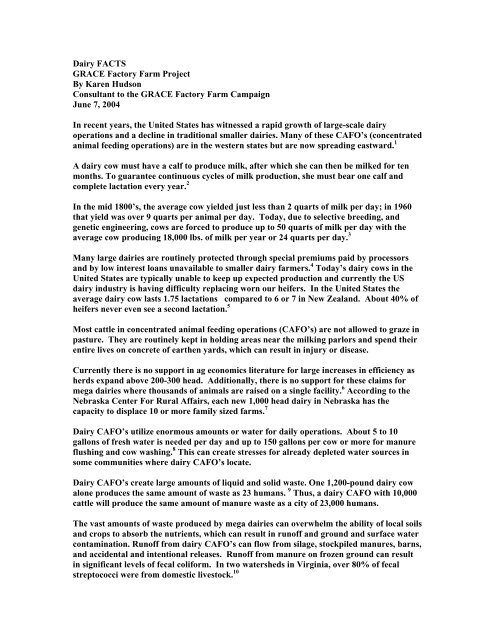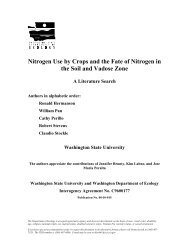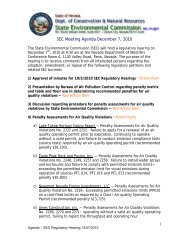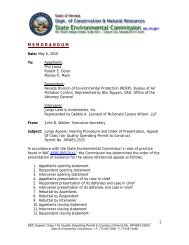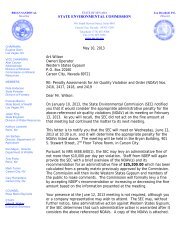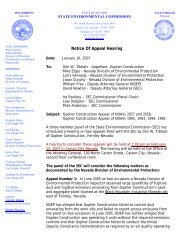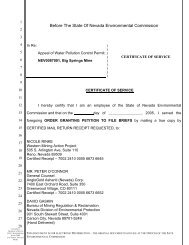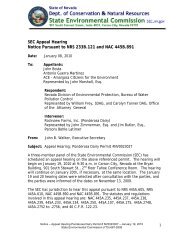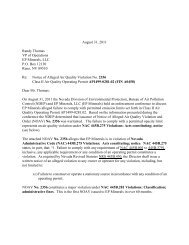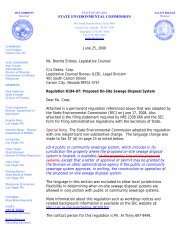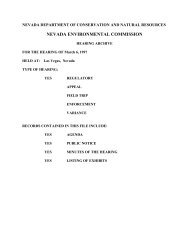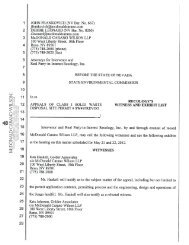Dairy FACTS GRACE Factory Farm Project By Karen Hudson ...
Dairy FACTS GRACE Factory Farm Project By Karen Hudson ...
Dairy FACTS GRACE Factory Farm Project By Karen Hudson ...
You also want an ePaper? Increase the reach of your titles
YUMPU automatically turns print PDFs into web optimized ePapers that Google loves.
<strong>Dairy</strong> <strong>FACTS</strong><br />
<strong>GRACE</strong> <strong>Factory</strong> <strong>Farm</strong> <strong>Project</strong><br />
<strong>By</strong> <strong>Karen</strong> <strong>Hudson</strong><br />
Consultant to the <strong>GRACE</strong> <strong>Factory</strong> <strong>Farm</strong> Campaign<br />
June 7, 2004<br />
In recent years, the United States has witnessed a rapid growth of large-scale dairy<br />
operations and a decline in traditional smaller dairies. Many of these CAFO’s (concentrated<br />
animal feeding operations) are in the western states but are now spreading eastward. 1<br />
A dairy cow must have a calf to produce milk, after which she can then be milked for ten<br />
months. To guarantee continuous cycles of milk production, she must bear one calf and<br />
complete lactation every year. 2<br />
In the mid 1800’s, the average cow yielded just less than 2 quarts of milk per day; in 1960<br />
that yield was over 9 quarts per animal per day. Today, due to selective breeding, and<br />
genetic engineering, cows are forced to produce up to 50 quarts of milk per day with the<br />
average cow producing 18,000 lbs. of milk per year or 24 quarts per day. 3<br />
Many large dairies are routinely protected through special premiums paid by processors<br />
and by low interest loans unavailable to smaller dairy farmers. 4 Today’s dairy cows in the<br />
United States are typically unable to keep up expected production and currently the US<br />
dairy industry is having difficulty replacing worn our heifers. In the United States the<br />
average dairy cow lasts 1.75 lactations compared to 6 or 7 in New Zealand. About 40% of<br />
heifers never even see a second lactation. 5<br />
Most cattle in concentrated animal feeding operations (CAFO’s) are not allowed to graze in<br />
pasture. They are routinely kept in holding areas near the milking parlors and spend their<br />
entire lives on concrete of earthen yards, which can result in injury or disease.<br />
Currently there is no support in ag economics literature for large increases in efficiency as<br />
herds expand above 200-300 head. Additionally, there is no support for these claims for<br />
mega dairies where thousands of animals are raised on a single facility. 6 According to the<br />
Nebraska Center For Rural Affairs, each new 1,000 head dairy in Nebraska has the<br />
capacity to displace 10 or more family sized farms. 7<br />
<strong>Dairy</strong> CAFO’s utilize enormous amounts or water for daily operations. About 5 to 10<br />
gallons of fresh water is needed per day and up to 150 gallons per cow or more for manure<br />
flushing and cow washing. 8 This can create stresses for already depleted water sources in<br />
some communities where dairy CAFO’s locate.<br />
<strong>Dairy</strong> CAFO’s create large amounts of liquid and solid waste. One 1,200-pound dairy cow<br />
alone produces the same amount of waste as 23 humans. 9 Thus, a dairy CAFO with 10,000<br />
cattle will produce the same amount of manure waste as a city of 23,000 humans.<br />
The vast amounts of waste produced by mega dairies can overwhelm the ability of local soils<br />
and crops to absorb the nutrients, which can result in runoff and ground and surface water<br />
contamination. Runoff from dairy CAFO’s can flow from silage, stockpiled manures, barns,<br />
and accidental and intentional releases. Runoff from manure on frozen ground can result<br />
in significant levels of fecal coliform. In two watersheds in Virginia, over 80% of fecal<br />
streptococci were from domestic livestock. 10
<strong>Dairy</strong> waste is often mixed with water and flushed into large open holes called lagoons.<br />
Studies show that groundwater quality can be endangered near CAFO’s due to leakage and<br />
seepage from lagoons which are large holes that store and minimally treat the waste after it<br />
is flushed and mixed with water. Results from a preliminary study from 7 dairy feedlots<br />
over 6 years point to the significant contamination from lagoons. Elevated levels of nitrate,<br />
ammonia, chloride, nitrogen and total dissolved solids were discovered in nearby<br />
monitoring wells. The study concluded that the mean concentration for all contaminants<br />
increased as dairy herds increased. 11 Waste lagoons, even with clay liners, allow<br />
contaminants to leach into the ground below the lagoon. At the maximum allowable rate a<br />
3-acre lagoon could legally leak more than a million gallon a year. 12<br />
Seepage from manure holding basins and lagoons can have a serious impact on ground<br />
water quality, especially from nitrate and ammonium. Even lined basins and lagoons, when<br />
properly constructed, can be a hazard when constructed in coarse textured soils or karst<br />
terrain. (sandy porous limestone) 13<br />
<strong>Dairy</strong> waste contains nitrogen and phosphorous compounds, which are called nutrients.<br />
These nutrients can overload natural waterways and cause algal blooms. Nitrogen and<br />
other contaminants can flow into groundwater and wells, making water unsafe for<br />
drinking. Runoff can also contain harmful pathogens that can cause human disease and<br />
death. 14<br />
Studies from an independent scientific organization show link between higher contaminations of<br />
well water near Concentrated Animal Feeding Operations.<br />
Water from wells used by low income residents in the Lower Yakima Valley have been tested this<br />
past year by the Valley Institute for Research and Education (VIRE). The study reveals a direct<br />
correlation between the location of large confined dairy operations and the pollution of private<br />
wells with E. Coli and high nitrate concentrations.<br />
The studies show that the wells in the area between Parker and Zillah, where there are a low<br />
number of factory dairies, have levels of nitrates below federal standards for nitrates (10 mg/l)<br />
and are absent for E. Coli contamination. The water falls within federal safe water guidelines.<br />
In sharp contrast, the areas between Granger and Grandview, where large numbers of cows are<br />
confined year round, high levels of nitrates and the presence of E.Coli have been found. 15<br />
Studies now show that pathogen loading of a concentrated operation such as a dairy is<br />
significantly higher that of rangeland fed cattle. Pathogens such as fecal coliform, ecoli,<br />
girardia lambia, and cryptosporidium exist in dairy manure, which can result in human<br />
illness if manure discharges or runoff occurs. 16 Four outbreaks of cryptosporidium have<br />
been linked to nonpoint agricultural pollution. 17<br />
Dr. Stephen D. Arnold, from New Mexico Sate University provides data on the impacts of<br />
dairies in a recent preliminary study measuring dairy feedlot contributions to groundwater<br />
contamination.<br />
Results from this preliminary study that analyzed groundwater quality data from seven dairy<br />
feedlots over a six-year period point to significant contamination problems. This study found<br />
elevated levels of nitrate, ammonia chloride, nitrogen, and total dissolved solids. Samples were<br />
obtained from groundwater monitoring wells located around dairy wastewater lagoons that were<br />
lined with clay, concrete, or synthetic membranes. Mean nitrate concentrations were significantly
higher in groundwater samples taken in the vicinity of lagoons with clay liners. The lagoons<br />
containing the synthetic membranes produced the lowest mean groundwater concentrations of<br />
ammonia and nitrate. Nitrate was the only groundwater contaminant measured that showed a<br />
consistently increasing trend from 1992-1997.<br />
The most important thing to note is that the mean concentrations for all contaminants tended to<br />
increase as the size of the dairy herds increased.<br />
Another preliminary study has recently been conducted to evaluate the health impact of dairy<br />
farms on surrounding rural communities in Southern New Mexico. In addition to groundwater<br />
contamination, other health concerns for rural populations surrounding dairy farms include odor,<br />
flies, and dust.<br />
<strong>Dairy</strong> CAFO’s produce dusts that may pose a greater risk than other types of dust. The dust from<br />
dried manure from dairies is agricultural organic dust, which can contain microorganisms,<br />
endotoxins, and aero-allergens. Inhalation of these can lead to several disease conditions in humans.<br />
Dairies can create dust from increased traffic due to constant deliveries of milk and supplies on<br />
rural roads. Dairies are also sources of hay and grain dust. 18<br />
The results Southern New Mexico study identified an association between living close to a<br />
dairy and a higher reported rate of diarrhea and asthma in children during the preceding<br />
three months. Several new studies have been released in the past few years regarding<br />
residents who live in the vicinity of hog factories. The preliminary results of this study<br />
findings mimic the findings in research which demonstrates that residents are experiencing<br />
health problems due to intensive livestock operations.<br />
Flies can be a significant agent or mechanical carries of disease and control of fly<br />
populations on dairies is difficult. The normal travel range of flies is one to two miles. Flies<br />
can spread a host of diseases dangerous to man, including salmonella, diarrhea,<br />
gastroenteritis, amoebic dysentery, and conjunctivitis. 19 Flies have recently been linked as<br />
a vector for cryptosporidium parvum. Two studies used infected bovine feces to yield these<br />
results. The studies suggest that if infected flies land on food, cryptosporidosis could also be<br />
a significant food borne infection. 20<br />
<strong>Dairy</strong> CAFO waste lagoons use anaerobic decomposition to break down waste material.<br />
Hog lagoons and manure disperse as many as 160 compounds that are created from the<br />
aerobic and anaerobic decomposition of waste. 21 One of the compounds produced is<br />
hydrogen sulfide. This gas has been proven to be a potent neurotoxin and has been<br />
linked to causing permanent and irreversible brain and nervous system damage, even at<br />
low ambient levels. 22<br />
According to Dr Kaye H. Kilburn, MD “even moderate occupational exposure and<br />
insidious downwind environmental occupational exposure to Hydrogen Sulfide can<br />
cause permanent impairment.” and “well beyond calling for epidemiologic studies, these<br />
findings imply that neighborhoods near refineries and other industrial sites where<br />
Hydrogen Sulfide is released deliberately of inadvertently are unsafe.” 23 Hydrogen<br />
sulfide gas can travel far beyond the confines of a facility and potentially damage<br />
human health. This toxic gas can also be expected to violate Minnesota State standards<br />
as far as five miles from livestock facilities according to the MPCA. 24
In 2003, toxic gas levels were measured at CAFO’s in Iowa and levels reached<br />
dangerous concentrations 22 times in the first months of evaluation. A monitor at an<br />
Atlantic- area dairy had seven ammonia readings above the limit of 15 parts per billion.<br />
Readings reached as high as 250 parts per billion for ammonia. The readings for<br />
hydrogen sulfide reached over 0 parts per billion for hydrogen sulfide at the Atlantic<br />
dairy.<br />
A recent study of bioaerosol distribution patterns from swine CAFO’s in the Midwest found<br />
that significant levels of staphylococci and fungus from the CAFO’s had aerosolized and<br />
traveled down wind. These contaminants were found in nearby residences. Also discovered<br />
outside the CAFO’s were antibiotic resistant bacteria. Neighbors in close proximity to these<br />
CAFO’s complained of serious odors emanating from the facilities, personal discomfort due<br />
to the odors, loss of sleep, possible allergic manifestations, and respiratory difficulties. This<br />
study underscores the potential dangers of CAFO’s and their impact on public health. The<br />
researchers summarized that animal confinement facilities should be sited with<br />
consideration of the location of human habitation. 25<br />
An Iowa study by J.A. Zahn, indicates that aerial transfer of antibiotics and antibiotic<br />
resistant bacteria from swine confinements may represent an important and previously<br />
overlooked mechanism for transfer of antibiotic resistance to humans and the environment.<br />
This study also concludes that neighbors of CAFO’s may be at risk. 26<br />
A NAS study released in 2002 points out that current EPA methods of measurement and<br />
calculation of projected pollutants based on numbers of animal units are not scientifically<br />
credible and further, there are no scientifically credible ways of calculating the impact of<br />
these pollutants from currently available, generalized models. Thus, establishing any<br />
credible measurements would require specific measurements at each location on days when<br />
the climatic conditions were the worst under every possible weather scenario and when it is<br />
most likely that the maximum amount of pollutant is being emitted from the facility under<br />
every possible mix of animals. Allowable emissions would then change based on the<br />
changing climatic conditions, changing terrain, changing temperature, and specific animal<br />
populations [not number of animal units].<br />
General standards cannot be developed because having a single measured standard that the<br />
facility must meet irrespective of the changing conditions listed above is not scientifically<br />
supportable.<br />
Respectfully submitted,<br />
<strong>Karen</strong> <strong>Hudson</strong><br />
Elmwood, Illinois<br />
FARM President (Families Against Rural Messes) www.farmweb.org<br />
<strong>GRACE</strong> <strong>Factory</strong> <strong>Farm</strong> <strong>Project</strong>
1<br />
. “There is a Future For Small Family <strong>Farm</strong>s” Feedstuffs Magazine. “<strong>Dairy</strong> industry Insider,” by Dr. Ken<br />
Bailey. 2000, Nov. 13.<br />
2<br />
Humane Society Regional News, p.1 “Mega <strong>Dairy</strong> <strong>Factory</strong> <strong>Farm</strong> Opposed in Illinois,” Spring 2001<br />
3<br />
Cohen, Robert, The Deadly Poison pp. 15, 16.<br />
4<br />
In Monstrous 20,000 Cow <strong>Factory</strong> <strong>Farm</strong>s, Hormone Injections Are Given Regularly- Abnormal Amounts<br />
of Milk Are the Goal,” Chris Bedford. AWI Quarterly p16. by Chris Bedford.<br />
5<br />
“Straight Talk,” The Milkweed. <strong>By</strong> Peter Hardin. Issue No. 264. July 2001.<br />
6<br />
Weida, William J. “Acitizens Guide to the Regional Economic and Environmental Effects of Large<br />
Concentrated <strong>Dairy</strong> Operations,” <strong>GRACE</strong> <strong>Factory</strong> <strong>Farm</strong> <strong>Project</strong> November, 19, 2000. p 26.<br />
7<br />
Nebraska Center For Rural Affairs Newsletter, “Nebraska Rural Action supplement, “Big Milk From Big<br />
Dairies,” July 2000. p.2.<br />
8<br />
Weida, William J. “Acitizens Guide to the Regional Economic and Environmental Effects of Large<br />
Concentrated <strong>Dairy</strong> Operations,” <strong>GRACE</strong> <strong>Factory</strong> <strong>Farm</strong> <strong>Project</strong> November, 19, 2000<br />
9<br />
Unites States Environmental Protection Agency<br />
10<br />
Weida, William J. “Acitizens Guide to the Regional Economic and Environmental Effects of Large<br />
Concentrated <strong>Dairy</strong> Operations,” <strong>GRACE</strong> <strong>Factory</strong> <strong>Farm</strong> <strong>Project</strong> November, 19, 2000. p.36.<br />
11<br />
“<strong>Dairy</strong> Feedlot Contributions to Groundwater Contamionation,” Steven D. Arnold, PhD.,Edward<br />
Meister, PhD. Environmental Health, September 1999. Abstract, p.16.<br />
12 Weida, William J. “Acitizens Guide to the Regional Economic and Environmental Effects of Large<br />
Concentrated <strong>Dairy</strong> Operations,” <strong>GRACE</strong> <strong>Factory</strong> <strong>Farm</strong> <strong>Project</strong> November, 19, 2000p. p.36.<br />
13<br />
Weida, William J. “Acitizens Guide to the Regional Economic and Environmental Effects of Large<br />
Concentrated <strong>Dairy</strong> Operations,” <strong>GRACE</strong> <strong>Factory</strong> <strong>Farm</strong> <strong>Project</strong> November, 19, 2000. p. 36<br />
14<br />
Weida, William J. “Acitizens Guide to the Regional Economic and Environmental Effects of Large<br />
Concentrated <strong>Dairy</strong> Operations,” <strong>GRACE</strong> <strong>Factory</strong> <strong>Farm</strong> <strong>Project</strong> November, 19, 2000. p 26.<br />
15<br />
Press Release CARE, January 13, 2003 Helen Reddout CARE Charles Tebbut Western Environmental<br />
Law Center<br />
16<br />
17<br />
Weida, William J. “Acitizens Guide to the Regional Economic and Environmental Effects of Large<br />
Concentrated <strong>Dairy</strong> Operations,” <strong>GRACE</strong> <strong>Factory</strong> <strong>Farm</strong> <strong>Project</strong> November, 19, 2000p. 33.<br />
18<br />
‘<strong>Dairy</strong> Herds and Rural Communities in Southern New Mexico,” by Stephen Arnold, PhD. July August<br />
1999, Environmental Health, p 15, 16.<br />
19<br />
<strong>Dairy</strong> Herds and Rural Communities in Southern New Mexico,” by Stephen Arnold, PhD. July August<br />
1999, Environmental Health, p.11<br />
20<br />
Flies Implicated as vector for Cryptosporidium,” Press Release: American Society for Microbilolgy<br />
November 2, 2000 Barbare Hyde 202-942-9206 bhyde@asmusa.org<br />
21<br />
Kendall Thu, PhD. Et al., eds., “Impacts of Large Scale Swine Production,” Proceedings from an<br />
Interdisciplinary Workshop, DesMoines, Iowa, June 29-30, 1995 p 47<br />
22<br />
Testimony of Kaye Kilburn, Ph.D. and Marvin Legator, Ph.D., presented at American Public Health<br />
Association meeting, November11, 1997, Indianapolis, Indiana, included in Hydrogen Sulfide letter to<br />
EPA, 1/25/99<br />
23 AFFADAVIT of Kaye Kilburn M.D. University of Southern California School of Medicine<br />
Environmental Sciences Laboratory Los Angeles California: Civil Action File No.: 970-CV-238<br />
24 Perry Beeman, “New Fears From Hog Lots: Odor May Spread Illness,” DesMoines Register 10/25/98<br />
25 “ Bioaerosol Disribution Patterns Adjaccent to Two Swine Growing Finishing Housed Confinement Units<br />
in the American Midwest,” P.V. Scarpino and H. Quinn, Department of Civil and Environmental<br />
Engineering, University of Cincinnati, Cincinnati, Ohio, 45221-0071 Source: Abstracts of the 14 th<br />
ANNUAL scientific Symposium of the Ohio River bBasin Consortium for Research and Education, Oct.<br />
14-16, 1998.<br />
26 J.A. Zahn, Evidence for Transfer of Tylosin and Tylosin-Resistant Bacteria in Air from Swine<br />
Production Facilities using Sub-Therapeutic Concentrations of Tylan in Feed.


